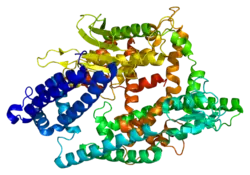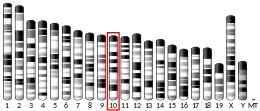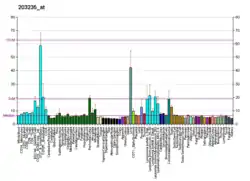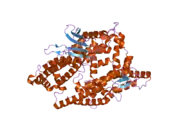THOP1
Thimet oligopeptidase is an enzyme that in humans is encoded by the THOP1 gene.[5][6]
| THOP1 | |||||||||||||||||||||||||||||||||||||||||||||||||||
|---|---|---|---|---|---|---|---|---|---|---|---|---|---|---|---|---|---|---|---|---|---|---|---|---|---|---|---|---|---|---|---|---|---|---|---|---|---|---|---|---|---|---|---|---|---|---|---|---|---|---|---|
 | |||||||||||||||||||||||||||||||||||||||||||||||||||
| |||||||||||||||||||||||||||||||||||||||||||||||||||
| Identifiers | |||||||||||||||||||||||||||||||||||||||||||||||||||
| Aliases | THOP1, EP24.15, MEPD_HUMAN, MP78, TOP, thimet oligopeptidase 1 | ||||||||||||||||||||||||||||||||||||||||||||||||||
| External IDs | OMIM: 601117 MGI: 1354165 HomoloGene: 55726 GeneCards: THOP1 | ||||||||||||||||||||||||||||||||||||||||||||||||||
| |||||||||||||||||||||||||||||||||||||||||||||||||||
| |||||||||||||||||||||||||||||||||||||||||||||||||||
| |||||||||||||||||||||||||||||||||||||||||||||||||||
| |||||||||||||||||||||||||||||||||||||||||||||||||||
| |||||||||||||||||||||||||||||||||||||||||||||||||||
| Wikidata | |||||||||||||||||||||||||||||||||||||||||||||||||||
| |||||||||||||||||||||||||||||||||||||||||||||||||||
References
- GRCh38: Ensembl release 89: ENSG00000172009 - Ensembl, May 2017
- GRCm38: Ensembl release 89: ENSMUSG00000004929 - Ensembl, May 2017
- "Human PubMed Reference:". National Center for Biotechnology Information, U.S. National Library of Medicine.
- "Mouse PubMed Reference:". National Center for Biotechnology Information, U.S. National Library of Medicine.
- Torres MP, Prange C, Lennon G (Dec 1998). "Human endopeptidase 24.15 (THOP1) is localized on chromosome 19p13.3 and is excluded from the linkage region for late-onset Alzheimer disease". Genomics. 53 (2): 239–40. doi:10.1006/geno.1998.5487. PMID 9790774.
- "Entrez Gene: THOP1 thimet oligopeptidase 1".
Further reading
- Thompson A, Huber G, Malherbe P (1995). "Cloning and functional expression of a metalloendopeptidase from human brain with the ability to cleave a beta-APP substrate peptide". Biochem. Biophys. Res. Commun. 213 (1): 66–73. doi:10.1006/bbrc.1995.2099. PMID 7639763.
- Papastoitsis G, Siman R, Scott R, Abraham CR (1994). "Identification of a metalloprotease from Alzheimer's disease brain able to degrade the beta-amyloid precursor protein and generate amyloidogenic fragments". Biochemistry. 33 (1): 192–9. doi:10.1021/bi00167a025. PMID 8286339.
- Dando PM, Brown MA, Barrett AJ (1993). "Human thimet oligopeptidase". Biochem. J. 294 (Pt 2): 451–7. doi:10.1042/bj2940451. PMC 1134475. PMID 8373360.
- Meckelein B, de Silva HA, Roses AD, et al. (1997). "Human endopeptidase (THOP1) is localized on chromosome 19 within the linkage region for the late-onset alzheimer disease AD2 locus". Genomics. 31 (2): 246–9. doi:10.1006/geno.1996.0041. PMID 8824811.
- Crack PJ, Wu TJ, Cummins PM, et al. (1999). "The association of metalloendopeptidase EC 3.4.24.15 at the extracellular surface of the AtT-20 cell plasma membrane". Brain Res. 835 (2): 113–24. doi:10.1016/S0006-8993(99)01494-8. PMID 10415366. S2CID 23769423.
- Pineau C, McCool S, Glucksman MJ, et al. (2000). "Distribution of thimet oligopeptidase (E.C. 3.4.24.15) in human and rat testes". J. Cell Sci. 112 (20): 3455–62. doi:10.1242/jcs.112.20.3455. PMID 10504294.
- Ferro ES, Tullai JW, Glucksman MJ, Roberts JL (1999). "Secretion of metalloendopeptidase 24.15 (EC 3.4.24.15)". DNA Cell Biol. 18 (10): 781–9. doi:10.1089/104454999314926. hdl:11449/37910. PMID 10541437.
- Tullai JW, Cummins PM, Pabon A, et al. (2001). "The neuropeptide processing enzyme EC 3.4.24.15 is modulated by protein kinase A phosphorylation". J. Biol. Chem. 275 (47): 36514–22. doi:10.1074/jbc.M001843200. PMID 10969067.
- Molina HM, Carmona AK, Kouyoumdjian M, Borges DR (2000). "Thimet oligopeptidase EC 3.4.24.15 is a major liver kininase". Life Sci. 67 (5): 509–20. doi:10.1016/S0024-3205(00)00650-0. PMID 10993116.
- Saric T, Beninga J, Graef CI, et al. (2001). "Major histocompatibility complex class I-presented antigenic peptides are degraded in cytosolic extracts primarily by thimet oligopeptidase". J. Biol. Chem. 276 (39): 36474–81. doi:10.1074/jbc.M105517200. PMID 11479311.
- Strausberg RL, Feingold EA, Grouse LH, et al. (2003). "Generation and initial analysis of more than 15,000 full-length human and mouse cDNA sequences". Proc. Natl. Acad. Sci. U.S.A. 99 (26): 16899–903. Bibcode:2002PNAS...9916899M. doi:10.1073/pnas.242603899. PMC 139241. PMID 12477932.
- Gioli-Pereira L, Fontenele-Neto JD, Borges DR, Kouyoumdjian M (2003). "Localization of EP24.15, a major liver kininase". J. Histochem. Cytochem. 51 (1): 125–7. doi:10.1177/002215540305100115. PMID 12502762.
- York IA, Mo AX, Lemerise K, et al. (2003). "The cytosolic endopeptidase, thimet oligopeptidase, destroys antigenic peptides and limits the extent of MHC class I antigen presentation". Immunity. 18 (3): 429–40. doi:10.1016/S1074-7613(03)00058-X. PMID 12648459.
- Ota T, Suzuki Y, Nishikawa T, et al. (2004). "Complete sequencing and characterization of 21,243 full-length human cDNAs". Nat. Genet. 36 (1): 40–5. doi:10.1038/ng1285. PMID 14702039.
- Ray K, Hines CS, Coll-Rodriguez J, Rodgers DW (2004). "Crystal structure of human thimet oligopeptidase provides insight into substrate recognition, regulation, and localization". J. Biol. Chem. 279 (19): 20480–9. doi:10.1074/jbc.M400795200. PMID 14998993.
- Grimwood J, Gordon LA, Olsen A, et al. (2004). "The DNA sequence and biology of human chromosome 19". Nature. 428 (6982): 529–35. Bibcode:2004Natur.428..529G. doi:10.1038/nature02399. PMID 15057824.
- Lehner B, Sanderson CM (2004). "A Protein Interaction Framework for Human mRNA Degradation". Genome Res. 14 (7): 1315–23. doi:10.1101/gr.2122004. PMC 442147. PMID 15231747.
- Saric T, Graef CI, Goldberg AL (2004). "Pathway for degradation of peptides generated by proteasomes: a key role for thimet oligopeptidase and other metallopeptidases". J. Biol. Chem. 279 (45): 46723–32. doi:10.1074/jbc.M406537200. PMID 15328361.
- Shivakumar BR, Wang Z, Hammond TG, Harris RC (2005). "EP24.15 interacts with the angiotensin II type I receptor and bradykinin B2 receptor". Cell Biochem. Funct. 23 (3): 195–204. doi:10.1002/cbf.1176. PMID 15376229. S2CID 5695331.
This article is issued from Wikipedia. The text is licensed under Creative Commons - Attribution - Sharealike. Additional terms may apply for the media files.






